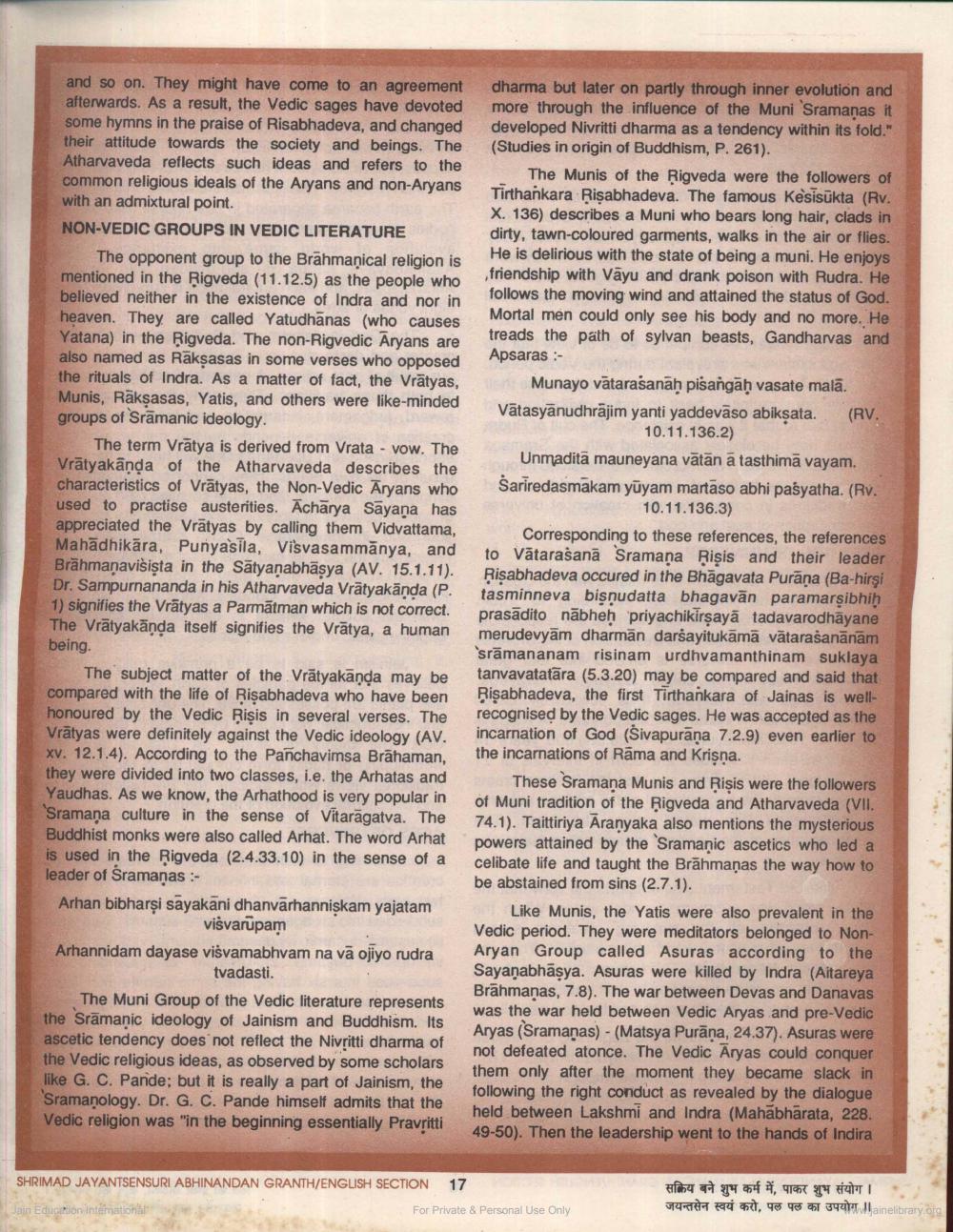Book Title: Antiquity or Jainism and tirthankara mahavir Author(s): Bhagchandra Jain Publisher: Z_Jayantsensuri_Abhinandan_Granth_012046.pdf View full book textPage 4
________________ and so on. They might have come to an agreement afterwards. As a result, the Vedic sages have devoted some hymns in the praise of Risabhadeva, and changed their attitude towards the society and beings. The Atharvaveda reflects such ideas and refers to the common religious ideals of the Aryans and non-Aryans with an admixtural point. NON-VEDIC GROUPS IN VEDIC LITERATURE The opponent group to the Brāhmaṇical religion is mentioned in the Rigveda (11.12.5) as the people who believed neither in the existence of Indra and nor in heaven. They are called Yatudhānas (who causes Yatana) in the Rigveda. The non-Rigvedic Aryans are also named as Raksasas in some verses who opposed the rituals of Indra. As a matter of fact, the Vrätyas, Munis, Rākşasas, Yatis, and others were like-minded groups of Srāmanic ideology. The term Vrātya is derived from Vrata - vow. The Vrātyakānda of the Atharvaveda describes the characteristics of Vrātyas, the Non-Vedic Aryans who used to practise austerities. Achārya Sāyana has appreciated the Vrätyas by calling them Vidvattama, Mahādhikāra. Punya'sila, Visvasammānya, and Brāhmanavišişta in the Sātyanabhāşya (AV. 15.1.11). Dr. Sampurnananda in his Atharvaveda Vrātyakānda (P. 1) signifies the Vrātyas a Parmātman which is not correct. The Vrätyakända itself signifies the Vrātya, a human being. The subject matter of the Vrātyakända may be compared with the life of Risabhadeva who have been honoured by the Vedic Risis in several verses. The Vrātyas were definitely against the Vedic ideology (AV. xv. 12.1.4). According to the Panchavimsa Brāhaman, they were divided into two classes, i.e. the Arhatas and Yaudhas. As we know, the Arhathood is very popular in Sramana culture in the sense of Vitaragatva. The Buddhist monks were also called Arhat. The word Arhat is used in the Rigveda (2.4.33.10) in the sense of a leader of Sramaņas :Arhan bibharşi sayakani dhanvārhanniskam yajatam višvarūpam Arhannidam dayase višvamabhvam na vā ojiyo rudra tvadasti. The Muni Group of the Vedic literature represents the Srämanic ideology of Jainism and Buddhism. Its ascetic tendency does not reflect the Nivritti dharma of the Vedic religious ideas, as observed by some scholars like G. C. Pande; but it is really a part of Jainism, the Sramanology. Dr. G. C. Pande himself admits that the Vedic religion was "in the beginning essentially Pravritti dharma but later on partly through inner evolution and more through the influence of the Muni Sramanas it developed Nivritti dharma as a tendency within its fold." (Studies in origin of Buddhism, P. 261). The Munis of the Rigveda were the followers of Tirthankara Risabhadeva. The famous Kesisukta (Rv. X. 136) describes a Muni who bears long hair, clads in dirty, tawn-coloured garments, walks in the air or flies. He is delirious with the state of being a muni. He enjoys friendship with Vāyu and drank poison with Rudra. He follows the moving wind and attained the status of God. Mortal men could only see his body and no more. He treads the path of sylvan beasts, Gandharvas and Apsaras : Munayo vātarasanah pisangāḥ vasate malā. Vātasyānudhrājim yanti yaddevāso abiksata. (RV. 10.11.136.2) Unmaditä mauneyana vātān ā tasthimā vayam. Sariredasmakam yuyam martaso abhi paśyatha. (Ry. 10.11.136.3) Corresponding to these references, the references to Vātarasana Sramana Risis and their leader Risabhadeva occured in the Bhāgavata Purana (Ba-hirsi tasminneva bisnudatta bhagavān paramarsibhih prasādito nābheh priyachikirsayā tadavarodhayane merudevyām dharmān darsayitukāmā vātarašanānam 'srāmananam risinam urdhvamanthinam suklaya tanvavatatāra (5.3.20) may be compared and said that Risabhadeva, the first Tirthankara of Jainas is wellrecognised by the Vedic sages. He was accepted as the incarnation of God (Sivapurana 7.2.9) even earlier to the incarnations of Rāma and Krişna. These Sramana Munis and Risis were the followers of Muni tradition of the Rigveda and Atharvaveda (VII. 74.1). Taittiriya Aranyaka also mentions the mysterious powers attained by the Sramanic ascetics who led a celibate life and taught the Brāhmaṇas the way how to be abstained from sins (2.7.1). Like Munis, the Yatis were also prevalent in the Vedic period. They were meditators belonged to NonAryan Group called Asuras according to the Sayanabhasya. Asuras were killed by Indra (Aitareya Brāhmanas, 7.8). The war between Devas and Danavas was the war held between Vedic Aryas and pre-Vedic Aryas (Sramanas) - (Matsya Purāna, 24.37). Asuras were not defeated atonce. The Vedic Aryas could conquer them only after the moment they became slack in following the right conduct as revealed by the dialogue held between Lakshmi and Indra (Mahabharata, 228. 49-50). Then the leadership went to the hands of Indira SHRIMAD JAYANTSENSURI ABHINANDAN GRANTH/ENGLISH SECTION 17 सक्रिय बने शुभ कर्म में, पाकर शुभ संयोग । - F , 46 39 Iainelibrary oja Join Education International For Private & Personal Use OnlyPage Navigation
1 2 3 4 5 6 7 8 9 10 11 12 13 14 15 16 17
